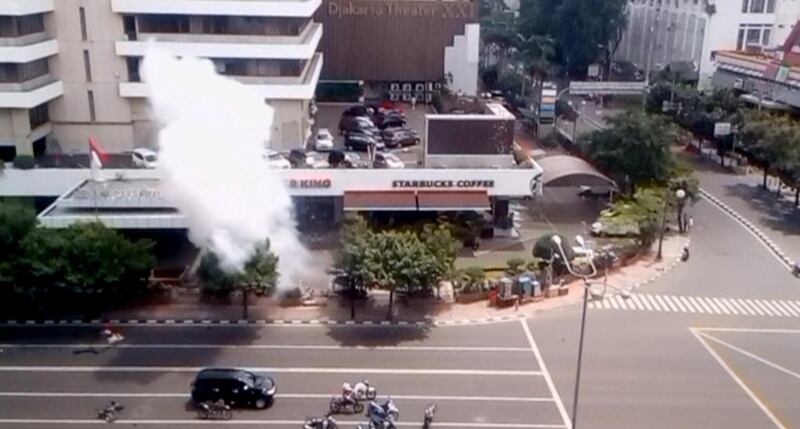JAKARTA // The first major terrorist attack in Jakarta in six years, in which five ISIL-linked militants were killed in a wild shoot-out and series of suicide bombings in the heart of the Indonesian capital, raises more questions than answers.
During the assault, police and witnesses said, at least two suicide bombers blew themselves up, while gunmen briefly took at least one foreigner hostage and fired at bystanders before taking part in a shoot-out with security forces. Bombs full of nails and screws were thrown at security forces, police said.
Thursday’s operation was a dramatic tactical departure from previous attacks in the city over the past decade or more, which all only involved single suicide bombers. But why were there only two victims – a traffic policeman and a Canadian citizen – when the gunmen had the opportunity to kill dozens more?
And why were the attackers only armed with pistols, in addition to grenades and improvised suicide devices, when weapons seized in raids on militants over the years suggest they would have had access to AK-47 assault rifles that would have caused far more carnage than the two dead and 24 wounded?
Even the location and the two targets were a puzzle – a small one-man police post in the middle of a busy thoroughfare and a Starbucks coffee outlet where a Canadian was briefly taken hostage before being killed. Four other foreigners were wounded.
Three of the attackers were shot by fast-reacting police and two others were shown blowing themselves up on live television, without making any effort to take anyone with them.
The attack did achieve its desired effect of putting the city back on edge, but given ISIL’s history of extreme brutality a more likely target would have been one of Jakarta’s giant malls, or even a five-star hotel.
The almost measured way the attack was carried out was typified by the spectacle of one of the gunmen, pistol raised in front of him, calmly walking past a large crowd of onlookers, including several unarmed policemen, seemingly firing aimlessly.
Police blamed the attack on Katibah Nusantara, a Southeast Asian militant group fighting in Iraq and Syria under ISIL that includes about 250 to 300 Indonesian fighters. The group’s chief recruiter in Indonesia is extremist Bahrun Naim. Naim is believed to have travelled to Raqqa, ISIL’s stronghold in eastern Syria, after he was released from prison where he was serving a sentence for arms possession in early 2015.
In recent months Naim has been agitating for extremists in Indonesia to mount terrorist attacks in the country to gain the attention of ISIL’s central leadership. The group has reportedly been considering the declaration of an official presence in the region.
The high number of Indonesian deaths among ISIL fighters in Iraq and Syria since March 2015 – more than 60 are believed to have been killed in battle against Kurdish forces and in coalition air strikes – may be another factor in shifting domestic violence back towards foreigners.
Police had rounded up 23 suspected militants in raids across Java, Indonesia's main island, over the previous three weeks. But because they came from different groups, Sidney Jones, terrorism expert and director of the Jakarta-based Institute for Policy Analysis of Conflict (IPAC), speaking to The National after Thursday's attack, ruled out the possibility that a much bigger, Paris-type attack had been prevented.
Still, the amount of explosives and weapons seized in the raids was evidence that supporters of extremist violence were still operating beneath the radar – even if Indonesia had not seen a major incident since the bombing of two downtown hotels in July 2009 that claimed seven lives.
Defending ISIL’s self-declared “caliphate” has so far been a greater priority for Indonesian extremists than targeting the Indonesian government or Western interests. But that could change over time, depending on how many fighters return home to breath new life into Indonesia’s moribund militant movement.
Previous bomb attacks in Indonesia, dating back to 2000, were carried out by the Al Qaeda-linked Jemaah Islamiyah. The group has since been largely broken up by Indonesian antiterrorism police who have arrested and jailed more than 700 militants associated with the group.
In a paper presented to a regional forum on Tuesday, Ms Jones said the most immediate danger was from cells of Indonesia’s local ISIL support network, especially if strengthened by training from one or two returned fighters.
“It is not a flood of returning fighters that poses the biggest risk now, but rather the existing cells on the ground whose members are eager to undertake attacks but lack the capacity to do so,” she said.
Certainly, the emergence of an ISIL structure in eastern Java last November under a single emir – who has not been named – has increased the pressure for extremist actions. But for these to succeed in terms of significant casualties and major publicity, they will need to be much better organised.
“Syrian-trained fighters could help, but now ISIS appears to need all the human resources it can muster to hang on to its territory in Syria and Iraq,” said Ms Jones. “It is hard to see how extending the jihad to Indonesia would be a priority.”
Still, the Indonesian government will have to pay special attention to the more than 200 of their citizens, about half of them women and children, who were expelled from Turkey and six other countries during 2015 before they could join ISIL.
Given the fact that they had no intention of coming back, many sold everything to finance the trip and have returned home destitute, presenting authorities with a test of the effectiveness of their deradicalisation and social welfare programmes.
It also a major challenge for anti-terrorism police, anxious to keep them under surveillance but with inadequate resources to do. Male fighters may be seen as the main threat, but Ms Jones says that some of the women are more militant and frustrated at not being given a more active role.
foreign.desk@thenational.ae





